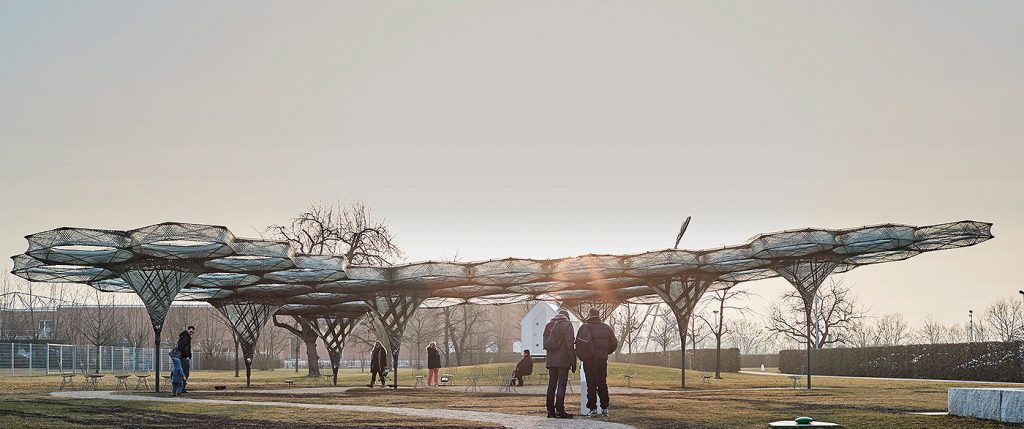
ELYTRA FILAMENT PAVILION
Vitra Campus, Weil am Rhein, 2017
With the exhibition »Hello, Robot. Design between Human and Machine«, the Vitra Design Museum presents a major exhibition that examines the current boom in robotics. It shows the variety of forms that robotics takes today and at the same time broadens our awareness of the associated ethical, social, and political issues. Outside the museum, the »Elytra Filament Pavilion« complements this exhibition.
The bionic baldachin is an impressive example of the growing influence of robotics on architecture. Its individual modules were defined by an algorithm and then produced with the help of an industrial robot, realised by a team from the University of Stuttgart. After its premiere at the Victoria & Albert Museum in London, it is now on view on the Vitra Campus.
The pavilion is the outcome of four years of ground-breaking research on the integration of architecture, engineering and biomimicry principles. The »Elytra Filament Pavilion« components have been fabricated by a robot at the University of Stuttgart. The 200m² structure is inspired by lightweight construction principles found in nature – the fibrous structures of the forewing shells of flying beetles known as elytra.
Experimental architect Achim Menges together with Moritz Dörstelmann, structural engineer Jan Knippers and climate engineer Thomas Auer have pioneered a unique robotic fabrication technique developed by the University of Stuttgart’s Institute for Computational Design (ICD) and the Institute of Building Structures and Structural Design (ITKE). This technique, developed by the team over several years of research, involves a novel way of winding composite materials. The innovative winding method has been designed to harness carbon fibres and give them strength as woven structural components. A series of these individual cell-like modules has been used to create the pavilion’s distinctive shape, integrating the processes of design and engineering. The project explores the impact of emerging computational and robotic technologies on these disciplines.
»Elytra’s« canopy is made up of 40 hexagonal component cells. On average they weigh 45kg each and take about three hours to make. These cells and the seven supporting columns were created by a computer-programmed Kuka robot in a four-month construction process at the ICD’s Computational Construction Laboratory in Stuttgart. To make each component, the robot wound resin-soaked glass and carbon fibres onto a hexagonal scaffold before hardening. Each cell and column is individual. Its final form of densely-wound fibres is a direct result of the changing stress conditions determined through structural simulation and testing carried out in advance by the ITKE. This enables an exceptionally lightweight structure that weighs less than 9kg per m², which equals 2.5 tonnes for the entire pavilion.
“With Elytra Filament Pavilion we aim to celebrate a truly contemporary and integrative approach to design, engineering and production, resulting in a distinctive spatial and aesthetic experience. (…) The canopy grows in response to real-time sensing data, showcasing the profound impact of emerging technologies and related new alliances between the fields of design, engineering and natural science. Through this we seek to provide visitors with a unique experience (…) that offers a glimpse of novel architectural and engineering possibilities, which may transform our built environment in the future.“
– Achim Menges
Vitra Webpage, Elytra Filament Pavilion
Vitra Design Musem, Elytra Filament Pavilion
Vitra Design Musem, Hello Robot Exhibition
DESIGN, ENGINEERING AND FABRICATION TEAM
Achim Menges with Moritz Dörstelmann
ICD – Institute for Computational Design, University of Stuttgart
Achim Menges Architect, Frankfurt
Team also includes: Marshall Prado (fabrication development), Aikaterini Papadimitriou, Niccolo Dambrosio, Roberto Naboni, with support by Dylan Wood, Daniel Reist
Jan Knippers
ITKE – Institute of Building Structures and Structural Design, University of Stuttgart
Knippers Helbig Advanced Engineering, Stuttgart, New York
Team also includes: Valentin Koslowski & James Solly (structure development), Thiemo Fildhuth (structural sensors)
Thomas Auer
Transsolar Climate Engineering, Stuttgart
Building Technology and Climate Responsive Design, TU München
Team also includes: Elmira Reisi, Boris Plotnikov
With the support of:
Michael Preisack, Christian Arias, Pedro Giachini, Andre Kauffman, Thu Nguyen, Nikolaos Xenos, Giulio Brugnaro, Alberto Lago, Yuliya Baranovskaya, Belen Torres, IFB University of Stuttgart (Prof. P. Middendorf)
Commission:
Victoria & Albert Museum, London 2016
FUNDING
The Elytra Filament Pavilion on the Vitra Campus has been realised with the generous support of:
Design Circle – Freunde des Vitra Design Museums e.V.
GETTY LAB
University of Stuttgart
The Elytra Filament Pavilion has been produced with the support of:
Victoria & Albert Museum, London
University of Stuttgart
Getty Lab
Kuka Roboter GmbH + Kuka Robotics UK Ltd
SGL Carbon SE
Hexion
Covestro AG
FBGS International NV
Arnold AG
PFEIFER Seil- und Hebetechnik GmbH
Stahlbau Wendeler GmbH + Co. KG
Lange+Ritter GmbH
STILL GmbH







